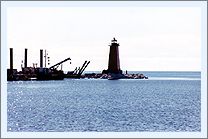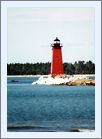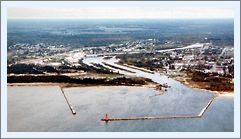|
Historical
Information

The Manistique river received its name from the French, and was
reportedly a corruption of the Ojibwa for "River of the big
bay," in reference to the significant river and its tributaries
which spread throughout a vast portion of Michigan's upper peninsula.
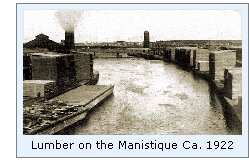 Realizing the vast profit potential to
be made in satiating Chicago's need for lumber after the great fire, and
the natural delivery system represented by the Manistique watershed,
Abijah Weston and his associates arrived in Manistique in 1872 ready to
reap the bounty of the areas seemingly limitless forest. Within a year,
the river mouth served as the receiving point for millions of logs
floated down the river from remote wilderness camps, and the twin
sawmills of the Chicago Lumbering Company and the Weston Lumber Company
were working overtime to serve the endless parade of lumber hookers and
schooners tied-up at the lumber-stacked wharves, waiting to carry their
cargoes to the bustling cities growing at the foot of the lake. Realizing the vast profit potential to
be made in satiating Chicago's need for lumber after the great fire, and
the natural delivery system represented by the Manistique watershed,
Abijah Weston and his associates arrived in Manistique in 1872 ready to
reap the bounty of the areas seemingly limitless forest. Within a year,
the river mouth served as the receiving point for millions of logs
floated down the river from remote wilderness camps, and the twin
sawmills of the Chicago Lumbering Company and the Weston Lumber Company
were working overtime to serve the endless parade of lumber hookers and
schooners tied-up at the lumber-stacked wharves, waiting to carry their
cargoes to the bustling cities growing at the foot of the lake.
In order to protect the mouth of the
river from silting, the lumber interests erected a pair of short timber
crib piers at the river mouth in the late 1870's and maintained lens
lanterns suspended from poles at their outer ends to assist captains
making their way into the harbor.
 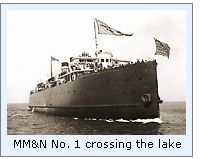 Seeing the potential for a rail line
connecting Manistique to lake Superior, Weston formed the Manistique and
Northwestern Railway Company in 1891 with the lines northern terminus at
Negaunee. With an expected increase in maritime traffic entering the
river, Ninth Lighthouse District Engineer Major Milton B. Adams
requested an appropriation of $32,000 for the establishment of a coast
light and fog signal at the harbor entrance in his annual report for
1892. While the act of February 15, 1893 gave Congressional approval to
the project, no appropriation was forthcoming, and without funding, the
project was stalled. Although the Lighthouse Board reiterated the
request for the following three years, the matter was dropped by the
Board in its annual reports after 1895. Seeing the potential for a rail line
connecting Manistique to lake Superior, Weston formed the Manistique and
Northwestern Railway Company in 1891 with the lines northern terminus at
Negaunee. With an expected increase in maritime traffic entering the
river, Ninth Lighthouse District Engineer Major Milton B. Adams
requested an appropriation of $32,000 for the establishment of a coast
light and fog signal at the harbor entrance in his annual report for
1892. While the act of February 15, 1893 gave Congressional approval to
the project, no appropriation was forthcoming, and without funding, the
project was stalled. Although the Lighthouse Board reiterated the
request for the following three years, the matter was dropped by the
Board in its annual reports after 1895.
By the turn of the century the
population of Manistique had grown to 3,500, with the mills employing
1,200 men, boasting a combined capital of $1,300,000, and producing
80,000,000 board feet of white pine a year. Additionally, prosperous new
businesses had joined the lumber interests along the lower five miles of
the river, notable among which was the Manistique Iron Company, which
was shipping 100 tons of pig iron a day. After establishing the Traverse
City, Leelanau & Manistique Railroad in 1901, which ran between
Northport to Traverse City, Weston launched the 338-foot car ferry
MANISTIQUE MARQUETTE AND NORTHERN No. 1 in December 1902, and began
daily railcar and mail service between Manistique and Northport soon
thereafter.
These were boom times for Manistique,
and while the federal government had undertaken a string of significant
harbor improvements throughout Lake Michigan since the 1850's, the entry
to the Manistique had somehow been overlooked. Forced to provide for
themselves, Manistique business interests had extended the timber crib
piers to 1,600 feet in length, and barely managed to maintain a depth of
11 feet in the 350-foot opening between the piers.
 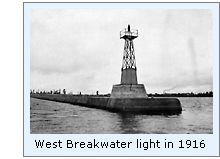 Applying all possible political
pressure, the city fathers of Manistique finally managed to convince the
Federal government of both the financial importance the businesses on
the river represented, and the need to ensure safe entry to the
increasingly larger vessels now plying the lakes. An Army
Corps of Engineers harbor expert was dispatched to Manistique in
early 1910, and plans were drawn up for a pair of concrete arrowhead
breakwaters on each side of the existing piers to create a large
stilling basin to both protect the river entry and to create a harbor of
refuge in which passing vessels could lay-up during foul weather
periods. Applying all possible political
pressure, the city fathers of Manistique finally managed to convince the
Federal government of both the financial importance the businesses on
the river represented, and the need to ensure safe entry to the
increasingly larger vessels now plying the lakes. An Army
Corps of Engineers harbor expert was dispatched to Manistique in
early 1910, and plans were drawn up for a pair of concrete arrowhead
breakwaters on each side of the existing piers to create a large
stilling basin to both protect the river entry and to create a harbor of
refuge in which passing vessels could lay-up during foul weather
periods.
The contract for the construction of
the breakwaters was awarded to the Greiling Brothers Company out of
Sturgeon Bay, who had established a solid reputation for harbor work in
a number of ports around Lake Michigan. With construction well underway
in 1910, George Putnam, the newly appointed Commissioner of lighthouses,
made the following observations in his annual report to Congress:
"car ferries between Frankfort and Manistique run the year round;
during the winter months this run, taking into consideration the nature
of the cargo carried and the dangers from ice is extremely hazardous; it
is therefore believed that every facility should be afforded for safe
navigation into this port, It is proposed to establish range lights with
fog signal and quarters for keepers." To this end, the report
included a request for $20,000 for the erection of the recommended
navigation aids, as follows: For two towers and fog-signal buildings
$7,000, illuminating apparatus $2,500, for fog signal apparatus $1,500,
$7,500 for a duplex dwelling and $1,500 to cover contingencies.
 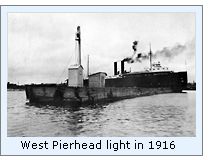 As work on the breakwaters progressed
through 1912, the Lighthouse Service erected temporary rage lights on
the east pier. Both lights were incandescent electric type, and powered
by the city electrical utility. The front range consisted of simple pole
with a 170 candlepower fixed white lens lantern suspended 25 feet above
lake level, and visible for a distance of 11 miles. The rear range, of
similar construction stood 50 feet above the water, and emitted 45
candlepower, and created a visible range of 7 miles. As work on the breakwaters progressed
through 1912, the Lighthouse Service erected temporary rage lights on
the east pier. Both lights were incandescent electric type, and powered
by the city electrical utility. The front range consisted of simple pole
with a 170 candlepower fixed white lens lantern suspended 25 feet above
lake level, and visible for a distance of 11 miles. The rear range, of
similar construction stood 50 feet above the water, and emitted 45
candlepower, and created a visible range of 7 miles.
Congress responded with the requested
$20,000 for permanent aids on October 22, 1913. Contracts were awarded
for supplying the necessary structural and mechanical components for the
new west breakwater that winter, and negotiations were undertaken for
the purchase of a site for the dwelling close to the foot of the new
East Breakwater.
 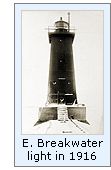 With the Greilling Brothers completion
of the west breakwater in the summer of 1914, lighthouse crews began
simultaneous construction of permanent lights on both the West
Breakwater and West pierhead. The West Breakwater structure took the
form of a white skeleton steel tower erected on a concrete pedestal atop
the surface of the concrete breakwater. Designed to operate as an
unmanned aid, the acetylene powered lens lantern was equipped with a sun
valve and flasher, to provide a characteristic 0.3 second flash every 3
seconds. By virtue of its location at a focal plane of 36 feet, the
120-candlepower white light was visible for a distance of 10 miles in
clear weather. To guide vessels round the West Pierhead, a simple white
post lantern was erected on outer end of the old timber pier. Standing
26 feet above lake level, the 60-candlepower acetylene light was visible
8 miles, and received its acetylene from tanks stored in a small wooden
building located beside the pole. Construction of the planned lighting
of the west side of the harbor entrance was thus complete, and the two
new lights were exhibited for the first time on the evening of October
30, 1914. With the Greilling Brothers completion
of the west breakwater in the summer of 1914, lighthouse crews began
simultaneous construction of permanent lights on both the West
Breakwater and West pierhead. The West Breakwater structure took the
form of a white skeleton steel tower erected on a concrete pedestal atop
the surface of the concrete breakwater. Designed to operate as an
unmanned aid, the acetylene powered lens lantern was equipped with a sun
valve and flasher, to provide a characteristic 0.3 second flash every 3
seconds. By virtue of its location at a focal plane of 36 feet, the
120-candlepower white light was visible for a distance of 10 miles in
clear weather. To guide vessels round the West Pierhead, a simple white
post lantern was erected on outer end of the old timber pier. Standing
26 feet above lake level, the 60-candlepower acetylene light was visible
8 miles, and received its acetylene from tanks stored in a small wooden
building located beside the pole. Construction of the planned lighting
of the west side of the harbor entrance was thus complete, and the two
new lights were exhibited for the first time on the evening of October
30, 1914.
 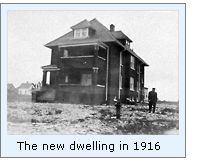 The Greilling Brothers completed work
on the new East Breakwater late in 1915, and a lighthouse crew arrived
to pour a large concrete slab 36 feet from the outer end of the
structure to serve as a foundation for the planned combination light
tower and fog signal building. The following year, while one crew worked
on building the station's duplex dwelling, another crew worked on
erecting the lighthouse tower at the end of the East Breakwater. Shipped
to the site in disassembled form, the tower was made of prefabricated
steel plates which were bolted together and lagged to the foundation.
Square in plan, the tower stood approximately 38 feet tall, and was
surmounted by a square gallery upon which a decagonal cast iron lantern
housed an electrically powered fixed red Fourth
Order Fresnel lens. Located at a focal plane of 50 feet, the
340-candlepower incandescent electric bulb within the lens would be
visible for a distance of 13 miles in clear weather. Within the body of
the structure, duplicate electrically powered compressors fed a pair of diaphone
fog signals which were programmed to emit a repeated
characteristic of a single 2-second blast followed by 18 seconds of
silence. Work on the new station was completed in August, and the light
exhibited for the first time on the evening of August 17, 1916. The Greilling Brothers completed work
on the new East Breakwater late in 1915, and a lighthouse crew arrived
to pour a large concrete slab 36 feet from the outer end of the
structure to serve as a foundation for the planned combination light
tower and fog signal building. The following year, while one crew worked
on building the station's duplex dwelling, another crew worked on
erecting the lighthouse tower at the end of the East Breakwater. Shipped
to the site in disassembled form, the tower was made of prefabricated
steel plates which were bolted together and lagged to the foundation.
Square in plan, the tower stood approximately 38 feet tall, and was
surmounted by a square gallery upon which a decagonal cast iron lantern
housed an electrically powered fixed red Fourth
Order Fresnel lens. Located at a focal plane of 50 feet, the
340-candlepower incandescent electric bulb within the lens would be
visible for a distance of 13 miles in clear weather. Within the body of
the structure, duplicate electrically powered compressors fed a pair of diaphone
fog signals which were programmed to emit a repeated
characteristic of a single 2-second blast followed by 18 seconds of
silence. Work on the new station was completed in August, and the light
exhibited for the first time on the evening of August 17, 1916.
 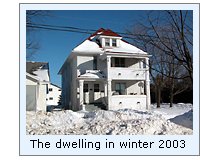 Over the ensuing fifty years,
Manistique's prominence lumbering port waned. With cessation of
Manistique and Lake Superior railroad operations, and the departure of
the last Ann Arbor car ferry from the harbor on July 18, 1968, the
harbors prominence plummeted. With advances in LORAN and Radar, manned
lights were no longer considered a necessity to navigation, and the
Manistique light was automated the following year, and the keeper's
dwelling sold into private ownership. As part of automation, the Fourth
Order Fresnel lens was removed and replaced by a 300 mm Tidelands Signal
acrylic optic. The Fourth Order lens was placed in storage, and
eventually restored and loaned to the Wisconsin Maritime Museum in
Manitowoc. Over the ensuing fifty years,
Manistique's prominence lumbering port waned. With cessation of
Manistique and Lake Superior railroad operations, and the departure of
the last Ann Arbor car ferry from the harbor on July 18, 1968, the
harbors prominence plummeted. With advances in LORAN and Radar, manned
lights were no longer considered a necessity to navigation, and the
Manistique light was automated the following year, and the keeper's
dwelling sold into private ownership. As part of automation, the Fourth
Order Fresnel lens was removed and replaced by a 300 mm Tidelands Signal
acrylic optic. The Fourth Order lens was placed in storage, and
eventually restored and loaned to the Wisconsin Maritime Museum in
Manitowoc.
  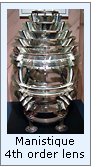 Unfortunately, Manistique's long
history of lumbering and industrialization has not been without penalty.
Contamination of the river life was initially noticed in the 1950's,
with PCB's and heavy metals found in the river sediment in the 1970's.
As a result, the site was designated as an official EPA "Area of
concern." The sources of this contamination were found to be
"wastes from the old sawmills, a paper mill, small industries,
residences, the municipal Wastewater Treatment Plant, and sandy
sediments which eroded from river banks as a result of log drives on the
river." As a result of a concerted clean-up effort over the past
twenty years, the middle and upper reaches of the Manistique River are
much cleaner now than they were 100 years ago. There is recreational
boating at the Marina and Harbor of Refuge, and a scenic 2.5 mile-long
boardwalk has been constructed along the river. Unfortunately, Manistique's long
history of lumbering and industrialization has not been without penalty.
Contamination of the river life was initially noticed in the 1950's,
with PCB's and heavy metals found in the river sediment in the 1970's.
As a result, the site was designated as an official EPA "Area of
concern." The sources of this contamination were found to be
"wastes from the old sawmills, a paper mill, small industries,
residences, the municipal Wastewater Treatment Plant, and sandy
sediments which eroded from river banks as a result of log drives on the
river." As a result of a concerted clean-up effort over the past
twenty years, the middle and upper reaches of the Manistique River are
much cleaner now than they were 100 years ago. There is recreational
boating at the Marina and Harbor of Refuge, and a scenic 2.5 mile-long
boardwalk has been constructed along the river.

Keepers of
this Light

Click Here to see a complete listing of
all Manistique East Breakwater Light keepers compiled by Phyllis L. Tag
of Great Lakes Lighthouse Research.

Finding this Light

To reach the east breakwater, take US-2 to the east side of Manistique, and
turn into Lakeview Park. Views of the lighthouse can be had from
throughout this park, and access to the pier can be gained at the west
end of the park. To reach the west pier, take the first southbound
street after crossing the river on US-2, and park alongside the road
opposite the wastewater treatment park, and walk down one of the worn
paths through the pine trees to the beach, and the west pier.

Reference Sources

Annual reports of the Lighthouse
Board, various, 1892 – 1909
Annual reports of the Lighthouse Service, various, 1910 – 1920
Great Lakes Light Lists, various, 1917 – 1953
Door County Advocate, April 27, 1911
M&LS Timeline, Ann Arbor Railroad Technical & Historical
Association website
History of the Great Lakes, J H Beers Co, 1899
The Long Ships Passing, Walter Havighurst, 1943.
A Souvenir of Manistique, Harold Press, 1902 (reprinted by
S.C.H.S., 1992)
Photograph of Manistique lens courtesy of Wisconsin Maritime
Museum
Keeper listings for this light appear courtesy of Great
Lakes Lighthouse Research
|
